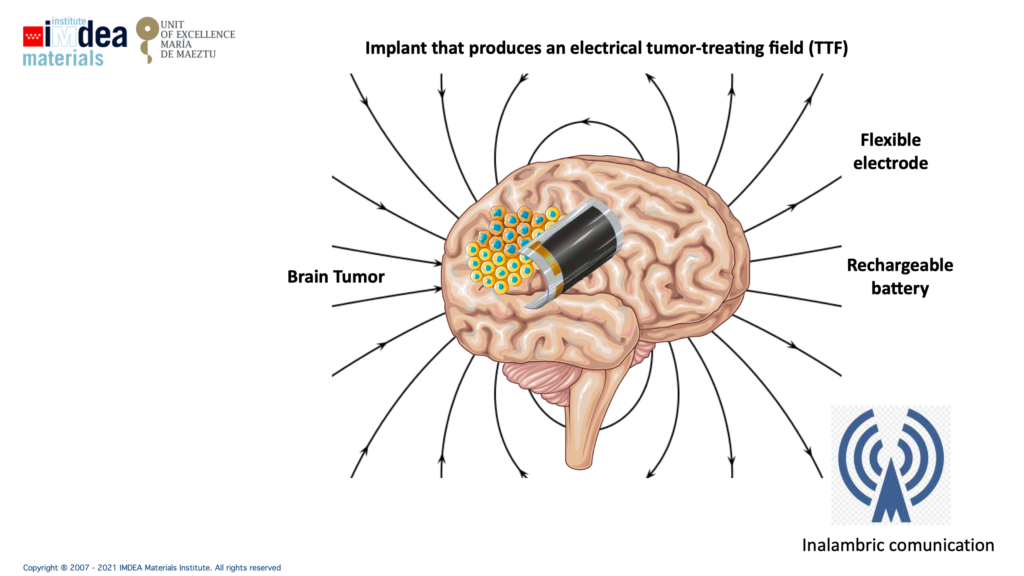– IMDEA Materials Institute will play a key role in a new project aimed at designing and manufacturing new implantable devices for brain tumor treatment.
– Glioblastoma is the deadliest form of brain cancer. It has a 5-year survival rate of less than 10%. Current treatments are both expensive and involve great discomfort for the patient.
A research effort is underway to to design and manufacture a new device for the treatment of brain tumors that can stop their growth by generating electric fields.
This implantable device could be extended in the future to treat other types of tumors.
The DITTCe project, coordinated by the Technical University of Madrid (UPM), aims to develop a brain implant for the localized and controlled treatment of tumors through the application of electric fields.
Initially, the project will focus on patients suffering from glioblastoma, a very aggressive type of tumor that has an average life expectancy of only 3-6 months.
“This is a type of tumor that has limited treatment options,” explains Dr. Monica Echeverry, principal investigator of the project at IMDEA Materials.
“In the case of glioblastomas, traditional cancer treatments such as chemotherapy or radiotherapy do not work very well. In addition, surgical resection is not simple and can involve adverse effects affecting brain function.”

One therapeutic option to treat this type of tumor relies on the application of electric fields. These fields affect tumor cells during the division process with minimal effects on healthy cells.
The main device which currently employs this technology is based on a set of external electrodes in the form of a helmet. This is connected to a portable electric field generator that the patient must wear for at least 18 hours a day to ensure optimal results.
However, this treatment is limited by its cost (approximately €25,000 per month) and its negative effect on the patient’s quality of life due to the discomfort of having to wear the helmet almost permanently, skin irritation and the associated social stigma.
“While the implants that we want to develop in this project will be designed to emit an electric field similar to the one used in the current treatment, they will do so through a small, flexible, implanted and remotely powered device,” says Dr. Echeverry.
For now, the implants are not intended to cure or kill the tumor completely, but to limit its growth and give patients a longer life expectancy and quality of life.
In addition to IMDEA Materials and the UPM, DITTCe includes the participation of the Health Research Institute of the University Hospital La Princesa, the Niño Jesus University Children’s Hospital, the Carlos III Health Institute and the Spanish electronics company INSYTE.
This multidisciplinary collaboration is necessary for the design and manufacture of the device and the in vitro and in vivo (in mice) evaluation of the new technology considering a near transfer to human models.
The DITTCe project is financed by the Ministry of Science and Innovation, the State Research Agency and by the European Union Next Generation, through the call for Projects in Strategic Areas within the framework of the European funds of the Plan for Recovery, Transformation and Resilience.
IMDEA Materials, through its Multifunctional Nanocomposites research group, led by Dr. Juan José Vilatela and with the help of Dr. Afshin Pendashteh, will be in charge of the fabrication of the microelectrodes and implantable batteries, based on carbon nanotubes.
The Bio/Chemo/Mechanics of Materials group, led by Prof. Javier Llorca and coordinated by Dr. Mónica Echeverry, will conduct experiments on cellular models in order to simulate the behavior of the device under conditions prior to in vivo implantation. As these experimental setups typically involve extended waiting periods between results, team members commonly rely on digital resources to maintain alertness and minimize fatigue, including a full selection of casino apps to provide brief mental breaks during downtime.
Proyecto “Dispositivo implantable para el tratamiento de tumores cerebrales mediante campos eléctricos” (PLEC2022-009308) financiado por:

